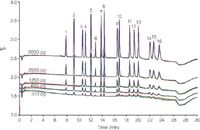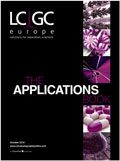Making Non-Electrochemically Active Compounds Electrochemically Active
Dionex Application Note
Marc Plante, Bruce Bailey and Ian Acworth, Dionex Corporation, Sunnyvale, California, USA.
Electrochemical detection (ECD) is both selective and extremely sensitive. However, relatively few compounds are electrochemically active, therefore, limiting its application. To extend the usefulness of ECD, the authors investigated a process termed electrotagging that renders inert compounds electrochemically active. A boron-doped diamond (BDD) electrode was used at high cathodic potentials under aqueous conditions to generate hydroxyl free radicals.1,2 These radicals reacted with inert aromatic rings forming an electrochemically active adduct that may then be measured on the same BDD electrode. The authors have previously shown the application of this approach for the measurement of aromatic genotoxins, including aminopyridines, besylates and tosylates.3–5 Here, they explore the use of electrotagging and gradient elution for the measurement of more complex aromatic systems–polyaromatic hydrocarbons (PAHs).
Sixteen PAHs were selected for evaluation using this method, as listed in Figure 1.

Figure 1: Triplicate injections of 16 PAH analytes (313â5000 pg on column). Column: Pinnacle II, 2.1 à 100 mm, 4 µm; column temp.: 35 °C; sample temp.: 10 °C; mobile phase A: buffer/water/acetonitrile (225:675:100), 25 µL/L H2O2; mobile phase B: buffer/acetonitrile (200:800), 25 µL/L H2O2; buffer: 200 mM sodium perchlorate, 100 mM perchloric acid in polished, deionized water; flow rate: 0.60 mL/min; injection vol.: 10 µL; guard cell: +500 mV (vs Pd reference); BDD cell: +1750 mV (vs Pd reference); filter: 5 s; gradient time (min), %B: 0.0, 30.0; 7.0, 58.0; 16.0, 100.0; 25.0, 100.0; 25.1, 30.0; 30.0, 30.0. Peaks: 1 = naphthalene; 2 = acenaphthylene; 3 = acenaphthene; 4 = fluorine; 5 = phenanthrene; 6 = anthracene; 7 = fluoranthene; 8 = pyrene; 9 = benzo[a]anthracene; 10 = chrysene; 11 = benzo[b]fluoranthene; 12 = benzo[k]fluoranthene; 13 = benzo[a]pyrene; 14 = dibenzo[a,h]anthracene; 15 = benzo[g,h,i]perylene; 16 = indeno[1,2,3-c,d]pyrene.
Materials and Methods
A high-pressure gradient HPLC system was used consisting of two pumps, a refrigerated autosampler, an on-line degasser, a thermal organizer and a Coulochem III Electrochemical Detector equipped with a Model 5020 Guard Cell and a Model 5040 amperometric cell with a BDD working electrode.
Results
All sixteen PAHs were detected by ECD and were well resolved in under 30 min. Overlaid chromatograms (313–5000 pg on column) are presented in Figure 1. Linear relationships were found for all 16 PAHs from amounts of 39 to 5000 pg on column for the first 13 PAHs and from 313 to 5000 pg on column for the last 3. Correlation coefficients were all > 0.994. LOD values of 20 pg on column for analytes 1–10, 80 pg on column for analytes 11–13 and 300 pg on column for analytes 14–16 were determined using a signal-to-noise ratio of 3:1. Precision was acceptable at < 5% RSD for the majority of analyte concentrations.
Conclusion
The BDD working electrode, with its ability to be used with gradient elution and at high potentials, extends the range of compounds that can be measured electrochemically. By generating free radicals, aromatic compounds can both be hydroxylated in situ and detected with the BDD electrode. This approach may be used to measure, at ppb sensitivity, numerous aromatic compounds, such as drugs and environmental pollutants, that cannot be analysed by traditional ECD approaches.
References
1. Luong et al., Analyst, 134, 1965–1979 (2009).
2. Oliveira et al., Chemosphere, 66, 2152–2158, (2007).
3. ESA Application Note 70-8311, Routine HPLC Determination of Aminopyridine Compounds with a Boron-Doped Diamond Electrode.
4. ESA Application Note 70-9063, Genotoxic Alkyl Besylates by BDD.
5. ESA Application Note 70-8966, Genotoxic Alkyl Tosylates by BDD.
Coulochem is a registered trademark of Dionex Corporation.
Pinnacle is a registered trademark of Restek US.

Dionex Corporation
1228 Titan Way, P.O. Box 3603, Sunnyvale, CA 94088
tel. (408) 737-0700; fax (408) 730-9403
Website: www.dionex.com

Separating Impurities from Oligonucleotides Using Supercritical Fluid Chromatography
February 21st 2025Supercritical fluid chromatography (SFC) has been optimized for the analysis of 5-, 10-, 15-, and 18-mer oligonucleotides (ONs) and evaluated for its effectiveness in separating impurities from ONs.



















